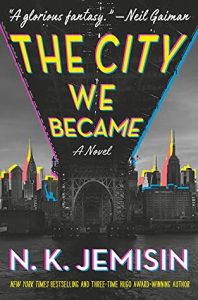
The City We Became, the first book in N. K. Jemisin’s Great Cities series, is a love letter to New York City, in all its exuberant, chaotic, contradictory glory. And to city life in general. The idea here is that when the conditions are right, with enough people packed into a small space, the city will come to life, literally, bestowing demigod-like powers on a resident chosen to be its avatar.
But the animation has unfortunate consequences. There are forces at work that don’t want new cities to come to life, and that will attack to prevent their birth, with disastrous results. Think Pompeii, Atlantis, New Orleans. The conflict is millennia-old, but in recent times the enemy has changed tactics, catching New York City’s midwives flat-footed.
The City We Became starts with a bang, following a young, homeless, Black graffiti artist painting throats so his still unborn city can breathe. And then he and the city become one, the city is in its birth throes, and the enemy strikes. They battle across the city, New York blocking eldritch tentacles with steel girders and bedrock. The Williamsburg bridge breaks, flinging commuters into the East River. The enemy takes a beating, but so does the city; its avatar is in a coma, easy prey when the enemy recovers.
But he is not alone in this fight. New York City has five boroughs, each with its own personality and chosen avatars, several women and one man who don’t particularly like each other. Will they be able to understand what the stakes are before it’s too late? Will they be able to overcome their differences and work together to protect the primary avatar? What will the others do when Staten Island tells them to get off her lawn?
This is a story, told with passion and humour, about NYC as a spicy, lumpy stew, celebrating all its various flavours, not as a melting pot enforcing homogeneity. I like that the characters are mostly decent, intelligent people trying to work together, trying to do the right thing. Even the villain has plausible reasons for her actions. Plus there’s an excellent send up of H. P. Lovecraft’s racism. But as much as I enjoyed The City We Became, I admit to some strong ambivalence towards it. It has a few problems:
- People of colour good, white bad: The recurring motif pitting multicultural/multiracial diversity against white bread uniformity and xenophobia was as subtle as a punch in the face. I can understand how Jemisin comes to that point of view, but still… I can’t do anything about my skin colour any more than she can.
- Pacing: The prologue gets the ball rolling just fine, but the story bogs down in the opening chapters. It’s not obvious to start with how the prologue relates to the amnesiac man on the train, and the explanation for his memory loss doesn’t come until a good ways in. The pace does pick up again by halfway through, and then it feels breakneck, with a rushed ending that left me doing a bit of head-scratching.
- Fridge logic: The fast pacing of the second half carries the reader along, too busy wondering what happens next to get bogged down in picking apart the hand-wavy explanations. On thinking about it afterwards, however, there’s far too much that doesn’t make sense. Mouse over for spoilers.
- Things get dropped: People, objects, and at least one idea. The trans roommate in Chapter Two was more appealing than the avatar character we’re following, but he’s dropped, never to be seen again. The avatar character drops his credit card in a park and walks away. A minor point, maybe, but it annoyed and distracted me through the next two chapters.
I never lived in NYC, but I spent thirty years in its bedroom suburbs in New Jersey. I’ve done all the touristy things in the city, gone shopping, ridden the subways, listened to the radio traffic reports with all their newcomer-unfriendly shorthand—the GWB (George Washington Bridge), the LIE (Long Island Expressway), etc—so I have a reasonable mental map of the place. If you don’t, Google Maps is your friend. There is a map at the beginning of the book, but in shades of grey on my e-reader’s small screen, I can’t make out many details. It does display the big blobs of the five boroughs, which is enough to show why Staten Island is more New Jersey than New York.
In sum, the book has a few problems, but it was a fun read. How can you go wrong with a book containing lines like this:
Discovering that one’s roommate is actively undergoing a break with reality is high on the scale of “things one wants to learn before signing the lease.”
Trigger warning: Lots of swearing, some violence, xenophobia, racism, attempted sexual assault, police brutality. Minor mentions: abortion, alcoholism.

Pingback: 2021 Recap | This Need To Read